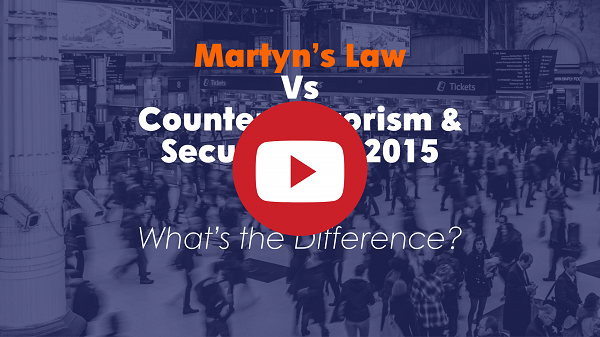Martyn's Law Vs Counter Terrorism & Security Act 2015 - What's the Difference?

You may ask yourself about the differences between Martyn’s Law and the Counter Terrorism and Security Act of 2015, and what implications they have to your organisation. While you may not feel an immediate need to act, understanding the differences between the two Laws can help you make a more informed decision about security measures and compliance.
In this article, I hope to provide clarity and answers to the questions you may have about Martyn’s Law and the Counter Terrorism and Security Act and empower you to assess their relevance to your organisation’s security strategy.
Want to dive into all the details, download our White Paper below.
1. Scope and Focus.
Martyn’s Law specifically targets security measures in public venues, and events open to the public, to prevent terrorist attacks. It emphasises the need for comprehensive risk assessments and public disclosure of security information by venue operators and event organisers.
The Counter Terrorism and Security Act takes a broader approach addressing issues such as radicalisation and the prevention of terrorism in various settings including schools, healthcare institutions and transportation hubs.
Other blogs you may be interested in:
- What is Martyn’s Law
- Does Martyn’s Law apply to my business?
- What are the Key Requirements for Martyn’s Law?
2. Risk Assessments
Martyn’s Law mandates thorough risk assessments tailored to the threat of terrorism for public venues and events open to the public. Venue operators or event organisers must identify potential risks and implement appropriate security measures to prevent them.
The Counter Terrorism and Security Act requires specified authorities to have due regard to the need to prevent people from being drawn into terrorism. It does not explicitly outline the same level of detail regarding risk assessments for public venues and events open to the public.
3. Public Disclosure of Security Information
Unlike existing legislation, Martyn’s law emphasises the public disclosure of security information by venue operators and event organisers. This include providing details about security measures, emergency evacuation procedures, and their planned response to a terrorist attack. It underlines the need to reassure the public.
While the Counter Terrorism and Security Act promotes collaboration and information sharing among the authorities to prevent terrorism, it does not specifically address the public disclosure of security information by private entities.
4. Government Oversight and Guidance
Martyn’s Law calls for government oversight and guidance to ensure effective compliance. The guidance, in for form of free training, resources and support is readily available online for venue operators and event organisers. While an independent body is yet to be formed for conducting audits and enforcing fines for non-compliance.
The Counter Terrorism and Security Act provides statutory guidance for implementing early intervention measures to prevent radicalisation, but it does not include the same level of government oversight and support for private entities in implementing security measures.
In conclusion
Martyn’s Law and the Counter Terrorism and Security Act 2015 represent significant legislative efforts to enhance security measures and prevent a terrorist attack. While both aim to address security concerns and increase public confidence, they differ in their scope and focus and in their requirements. Hopefully this article has helped clarify the difference between the two Laws and answered any questions you have regarding the implications to your business.
As security management professionals, if offer our expertise and guidance to business to support them complying with Martyn’s Law. If you would like help navigating the complexities for your business, look here.





